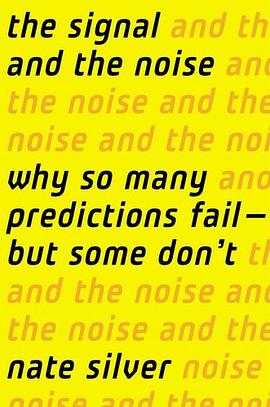The Signal and the Noise
内容简介
"Nate Silver's The Signal and the Noise is The Soul of a New Machine for the 21st century."
—Rachel Maddow, author of Drift
Nate Silver built an innovative system for predicting baseball performance, predicted the 2008 election within a hair’s breadth, and became a national sensation as a blogger—all by the time he was thirty. The New York Times now publishes FiveThirtyEight.com, where Silver is one of the nation’s most influential political forecasters.
Drawing on his own groundbreaking work, Silver examines the world of prediction, investigating how we can distinguish a true signal from a universe of noisy data. Most predictions fail, often at great cost to society, because most of us have a poor understanding of probability and uncertainty. Both experts and laypeople mistake more confident predictions for more accurate ones. But overconfidence is often the reason for failure. If our appreciation of uncertainty improves, our predictions can get better too. This is the “prediction paradox”: The more humility we have about our ability to make predictions, the more successful we can be in planning for the future.
In keeping with his own aim to seek truth from data, Silver visits the most successful forecasters in a range of areas, from hurricanes to baseball, from the poker table to the stock market, from Capitol Hill to the NBA. He explains and evaluates how these forecasters think and what bonds they share. What lies behind their success? Are they good—or just lucky? What patterns have they unraveled? And are their forecasts really right? He explores unanticipated commonalities and exposes unexpected juxtapositions. And sometimes, it is not so much how good a prediction is in an absolute sense that matters but how good it is relative to the competition. In other cases, prediction is still a very rudimentary—and dangerous—science.
Silver observes that the most accurate forecasters tend to have a superior command of probability, and they tend to be both humble and hardworking. They distinguish the predictable from the unpredictable, and they notice a thousand little details that lead them closer to the truth. Because of their appreciation of probability, they can distinguish the signal from the noise.
With everything from the health of the global economy to our ability to fight terrorism dependent on the quality of our predictions, Nate Silver’s insights are an essential read.
......(更多)
作者简介
Nate Silver is a statistician, writer, and founder of The New York Times political blog FiveThirtyEight.com. Silver also developed PECOTA, a system for forecasting baseball performance that was bought by Baseball Prospectus. He was named one of the world’s 100 Most Influential People by Time magazine. He lives in Brooklyn, New York.
......(更多)
目录
Introduction 1
1 A Catastrophic Failure of Prediction 19
2 Are You Smarter Than a Television Pundit? 47
3 All I Care About is W's and L's 74
4 For Years You've Been Telling Us that Rain is Green 108
5 Desperately Seeking Signal 142
6 How to Drown in Three Feet of Water 176
7 Role Models 204
8 Less and Less and Less Wrong 232
9 Rage Against the Machines 262
10 The Poker Bubble 294
11 If You Can't Beat'em … 329
12 A Climate of Healthy Skepticism 370
13 What You Don't Know Can Hurt You 412
Conclusion 446
Acknowledgments 455
Notes 459
Index 515
......(更多)
读书文摘
Before we demand more of our data, we need to demand more of ourselves.
预测时,我们需要在好奇和怀疑之间寻求平衡。这两者是可以相互协调和融合的。我们越是渴望检验自己的假设,就越愿意承认我们关于世界的知识存在很多不确定,越愿意承认不可能做出完美的预测,越不会陷入失败的恐慌中,也会有更多的自由让思维驰骋。对自己不了解的事物作进一步的了解,我们也许就能做出更多准确的预测。
......(更多)






